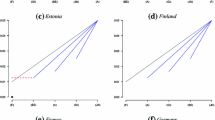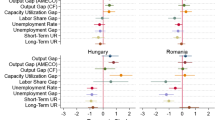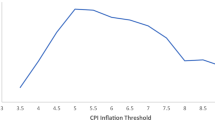Abstract
The aim of this paper is to conduct empirical research on Japanese inflation dynamics through GMM estimations by applying the modified Woodford (2003)-type New Keynesian Phillips Curve (NKPC) which incorporates staggered price and wage setting, by using quarterly data spanning the period 1980:1 to 2010:4. The result of estimation leads our empirical study to conclude that the backward-looking component tends to have a stronger impact on inflation dynamics than the forward-looking one. Further, the investigation of flattening of the NKPC implies that it is rather flat, and that downward nominal wage rigidity is related to this in recent years. Thus, the conduct of monetary policy by the central bank faces a certain difficulty in recent years.
Similar content being viewed by others
References
Akerlof, G. A., Dickens, W. T., and G. L. Perry. 1996. “The Macroeconomics of Low Inflation,” in Perry, G. L., and W. C. Brainard, eds., Brookings Papers on Economic Activity, 1996(1): 1–76.
Calvo, G. 1983. “Staggered Prices in a Utility Maximizing Framework,” Journal of Monetary Economics, 12(3): 383–398.
Christiano, L., Eichenbaum, M., and C. Evans. 2001. “Nominal Rigidities and the Dynamic Effects of a Shock to Monetary Policy,” NBER Working Paper Series, 8403.
Christiano, L., Eichenbaum, M., and C. Evans. 2005. “Nominal Rigidities and the Dynamic Effects of a Shock to Monetary Policy,” Journal of Political Economy, 113(1): 1–45.
Clarida, R., Galí, J., and M. Gertler. 1999. “The Science of Monetary Policy: A New Keynesian Perspective,” Journal of Economic Literature, 37(4): 1661–1707.
Erceg, C., Henderson, D., and A. Levin. 2000. “Optimal Monetary Policy with Staggered Wage and Price Contracts,” Journal of Monetary Economics, 46(2): 281–313.
Galí, J., and M. Gertler. 1999. “Inflation Dynamics: A Structural Econometric Analysis,” Journal of Monetary Economics, 44(2): 195–222.
Galí, J. 2008. Monetary Policy, Inflation, and the Business Cycle: An Introduction to the New Keynesian Framework, Princeton: Princeton University Press.
Galí, J., Gertler, M., and D. López-Salido. 2001. “European Inflation Dynamics,” European Economic Review, 45(7): 1237–1270.
Galí, J., Gertler, M., and D. López-Salido. 2005. “Robustness of the Estimates of the Hybrid New Keynesian Phillips Curve,” Journal of Monetary Economics, 52(6): 1107–1118.
Galí, J., Gertler, M., and D. López-Salido. 2007. “Markups, Gaps and the Welfare Costs of Business Fluctuations,” Review of Economics and Statistics, 89(1): 44–59.
Giannoni, M. P., and M. Woodford. 2003. “Optimal Inflation-Targeting Rules,” NBER Working Paper Series, 9939.
Giannoni, M. P., and M. Woodford. 2005. “Optimal Inflation-Targeting Rules,” in Bernanke, B. S., and M. Woodford, (eds.), The Inflation-Targeting Debate, National Bureau of Economic Research: 93–172.
Goodfriend, M., and R. G. King. 1997. “The New Neoclassical Synthesis and the Role of Monetary Policy,” in Bernanke, B. S., and J. J. Rotemberg, (eds.), NBER Macroeconomics Annual 1997, 12, Cambridge, MA: MIT Press: 231–283.
Hodrick, R. J., and E. C. Prescott. 1997. “Postwar U.S. Business Cycles: An Empirical Investigation,” Journal of Money, Credit, and Banking, 29(1): 1–16.
Iakova, D. 2007. “Flattening of the Phillips Curve: Implications for Monetary Policy,” IMF Woking Paper, 07–76.
Kuester, K., Müller, G. J., and S. Stölting. 2009. “Is the New Keynesian Phillips Curve Flat?” Economics Letters, 103(1): 39–41.
Lindé, J. 2005. “Estimating New-Keynesian Phillips Curves: A Full Information Maximum Likelihood Approach,” Journal of Monetary Economics, 52(6): 1135–1149.
Mazumder, S. 2010. “The New Keynesian Phillips Curve and the Cyclicality of Marginal Cost,” Journal of Macroeconomics, 32(3): 747–765.
Nelson, E. 1998. “Sluggish Inflation and Optimizing Models of the Business Cycle,” Journal of Monetary Economics, 42. 303–322.
Newey, W., and K. West. 1987. “A Simple, Positive Semidefinite, Heteroskedasticity and Autocorrelation Consistent Covariance Matrix,” Econometrica, 55(3): 703–708.
Rotemberg, J. 1982a. “Sticky Prices in the United States,” Journal of Political Economy, 90(6): 1187–1211.
Rotemberg, J. 1982b. “Monopolistic Price Adjustment and Aggregate Output,” Review of Economic Studies, 49(4): 517–531.
Rotemberg, J., and M. Woodford. 1997. “An Optimization-Based Econometric Framework for the Evaluation of Monetary Policy,” in Bernanke, B. S., and J. J. Rotemberg, (eds.), NBER Macroeconomic Annual 1997, 12. 297–346.
Rotemberg, J., and M. Woodford. 1999. “The Cyclical Behavior of Prices and Costs,” in Taylor, J., and M. Woodford, (eds.), Handbook of Macroeconomics, North-Holland: Elsevier, 1(1), chapter 16. 1051–1135.
Rudd, J., and K. Whelan. 2005a. “Does Labor’s Share Drive Inflation?” Journal of Money, Credit, and Banking, 37(2): 297–312.
Rudd, J., and K. Whelan. 2005b. “New Tests of the New-Keynesian Phillips Curve,” Journal of Monetary Economics, 52(6): 1167–1181.
Rudd, J., and K. Whelan. 2006. “Can Rational Expectations Sticky-Price Models Explain Inflation Dynamics?” American Economic Review, 96(1): 303–320.
Rudd, J., and K. Whelan. 2007. “Modeling Inflation Dynamics: A Critical Review of Recent Research,” Journal of Money, Credit, and Banking, 39(s1): 155–170.
Sbordone, A. 2002. “Prices and Unit Labor Costs: A New Test of Price Stickiness,” Journal of Monetary Economics, 49(2): 265–292.
Sbordone, A. 2005. “Do Expected Future Marginal Costs Drive Inflation Dynamics?” Journal of Monetary Economics, 52(6): 1183–1197.
Smets, F., and R. Wouters. 2003. “An Estimated Dynamic Stochastic General Equilibrium Model of the Euro Area,” Journal of the European Economics Association, 1(5): 1123–1175.
Steinsson, J. 2003. “Optimal Monetary Policy in an Economy with Inflation Persistence,” Journal of Monetary Economics, 50(7): 1425–1456.
Taylor, J. 1979. “Staggered Wage Setting in a Macro Model,” American Economic Review, 69(2): 108–113.
Taylor, J. 1980. “Aggregate Dynamics and Staggered Contracts,” Journal of Political Economy, 88(1): 1–23.
Walsh, C. E. 2010. Monetary Theory and Policy, 3rd ed., Cambridge: MIT Press.
Woodford, M. 2001. “The Taylor Rule and Optimal Monetary Policy,” American Economic Review, 91(2): 232–237.
Woodford, M. 2003. Interest and Prices, Princeton: Princeton University Press.
Zhang, C., and J. Clovis. 2010. “The New Keynesian Phillips Curve of Rational Expectations: A Serial Correlation Extension,” Journal of Applied Economics, 37(2): 159–179.
Author information
Authors and Affiliations
Corresponding author
Rights and permissions
About this article
Cite this article
Nakahira, K. The new Keynesian Phillips Curve for Japan — an Empirical Analysis —. IJEPS 6, 99–119 (2011). https://doi.org/10.1007/BF03405734
Published:
Issue Date:
DOI: https://doi.org/10.1007/BF03405734




